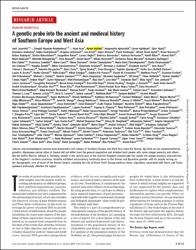| dc.contributor.author | Açıkkol, Ayşen | |
| dc.date.accessioned | 2023-04-04T10:54:19Z | |
| dc.date.available | 2023-04-04T10:54:19Z | |
| dc.date.issued | 2022 | tr |
| dc.identifier.uri | https://www.science.org/doi/10.1126/science.abq0755 | |
| dc.identifier.uri | https://hdl.handle.net/20.500.12418/13297 | |
| dc.description.abstract | Literary and archaeological sources have preserved a rich history of Southern Europe and West Asia since the Bronze Age that can be complemented by genetics. Mycenaean period elites in Greece did not differ from the general population and included both people with some steppe ancestry and others, like the Griffin Warrior, without it. Similarly, people in the central area of the Urartian Kingdom around Lake Van lacked the steppe ancestry characteristic of the kingdom’s northern provinces. Anatolia exhibited extraordinary continuity down to the Roman and Byzantine periods, with its people serving as the demographic core of much of the Roman Empire, including the city of Rome itself. During medieval times, migrations associated with Slavic and Turkic speakers profoundly affected the region. | tr |
| dc.language.iso | eng | tr |
| dc.publisher | American Association for the Advancement of Science | tr |
| dc.relation.isversionof | 10.1126/science.abq0755 | tr |
| dc.rights | info:eu-repo/semantics/openAccess | tr |
| dc.subject | Ancient DNA, Europe, Turkey, Migration, Urartian Kingdom, Roman and Byzantine Empires | tr |
| dc.title | A genetic probe into the ancient and medieval history of Southern Europe and West Asia | tr |
| dc.type | article | tr |
| dc.relation.journal | SCIENCE | tr |
| dc.contributor.department | Edebiyat Fakültesi | tr |
| dc.contributor.authorID | 0000-0003-1086-9749 | tr |
| dc.identifier.volume | 377 | tr |
| dc.identifier.issue | 6609 | tr |
| dc.identifier.endpage | 951 | tr |
| dc.identifier.startpage | 940 | tr |
| dc.relation.publicationcategory | Uluslararası Hakemli Dergide Makale - Kurum Öğretim Elemanı | tr |















